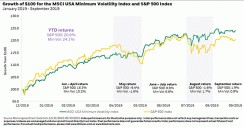Editor’s note: “Risk” is quite possibly the most prevalent topic on investors’ minds at any given moment (along with returns, of course). But do all investors perceive risk the same way – and does it matter if they do? It’s an intriguing question, and one II asked guest writer Holly Framstead, CFA, to share her view on. Framstead is the Head of U.S. Factor ETFs within BlackRock’s ETF and Index Investment Group.
What does the word “risk” mean to you? In asset management, risk is commonly defined as standard deviation, or how much an investment’s returns vary from its mean return. However, I often find clients don’t think of risk in those terms, making some conversations difficult. Instead, many investors equate risk simply with losing money. The question then becomes: “Is there an alternative measure that can help clients better understand and therefore more appropriately manage risk?” One such measure is upside/downside capture.
Redefining risk
The concept of upside/downside capture is fairly simple. “Upside” is defined as periods when the market earned positive returns, while “downside” refers to periods when the market earned negative returns. “Capture” indicates how much an investment participated in the market return. All else equal, it is considered desirable to capture more than 100% of the market’s upside (increase more), and less than 100% of the downside (decline less).
Read more from Holly Framstead.
One strategy that has been appealing when it comes to capturing less market downside is minimum volatility.1 Minimum volatility is designed to reduce risk, while maintaining 100% equity exposure. Why is this important? Humans tend to experience the pain of losses more than the joys of equivalent gains, a bias known as “loss aversion.” Loss aversion is one reason many investors closely identify risk with losing money, rather than its true definition of standard deviation. This bias can result in impulsive (and likely bad) decisions when the value of their portfolio decreases. For example, due to fear of loss, many investors pulled their money out of the market in the fourth-quarter turmoil of 2018 only then to miss the market rally in early 2019. Minimum volatility strategies may help prevent these negative impulsive investor actions by reducing risk in a manner that resonates with investors–encouraging them to stay invested in periods of market stress and helping to keep them on track toward their long-term financial goals.
Understanding winning by losing less
When we say that U.S. minimum volatility has captured 80% of the upside of the S&P 500 but only 59% of the downside, many investors assume that means the strategy has lagged but with lower risk. Yet, since its inception in 2008, minimum volatility has outperformed the S&P 500 by 2% annualized.2 How can a strategy that captures less upside outperform over the long term? The answer is simple – minimum volatility has been able to historically deliver superior returns by declining less during market drawdowns. Said differently, the strategy has won by losing less.Let’s use 2019 as an example. Through September of this year, minimum volatility is up 24.1% while the S&P 500 is up 20.6%.3 How can this be?

Despite a positively trending market for most of the year, US Large cap stocks4 have experienced moments of significant weakness where minimum volatility has outperformed. In May, the S&P 500 declined -6.4% while minimum volatility declined only -1.6%. In August, the S&P 500 declined -1.6% and minimum volatility gained 1.7%.5 Losing less in 2019, minimum volatility returns have compounded to better returns in aggregate over the year. This idea of winning by losing less translates into the longer-term results of minimum volatility as well. In fact, by capturing the lion’s share of the upside but significantly mitigating the downside, minimum volatility has historically been able to beat the market’s return since inception, while also delivering on risk reduction.

A map for navigating uncertainty
In today’s uncertain environment there is no shortage of ways investors can lose money. Strategies that focus on limiting volatility can add resilience, while offering investors the comfort to stay invested in the market through all environments. Think of upside/downside capture as one way to provide clarity on the road to pursuing long-term investment objectives.
1 Represented by the MSCI USA Minimum Volatility Index.
2 Source: Morningstar direct. Data from 06/2/2008 – 9/30/2019. Inception date of the MSCI USA Minimum Volatility Index is June 2, 2008.
3 Source: Morningstar Direct. Data from 1/1/2019 – 9/30/2019.
4 U.S. large cap stocks represented by the S&P 500 Index.
5 Source: Morningstar Direct.
Carefully consider the Funds’ investment objectives, risk factors, and charges and expenses before investing. This and other information can be found in the Funds’ prospectuses or, if available, the summary prospectuses which may be obtained by visiting www.iShares.com or www.blackrock.com. Read the prospectus carefully before investing.
Investing involves risks, including possible loss of principal.
The iShares Minimum Volatility Funds may experience more than minimum volatility as there is no guarantee that the underlying index’s strategy of seeking to lower volatility will be successful.
There can be no assurance that performance will be enhanced or risk will be reduced for funds that seek to provide exposure to certain quantitative investment characteristics (“factors”). Exposure to such investment factors may detract from performance in some market environments, perhaps for extended periods. In such circumstances, a fund may seek to maintain exposure to the targeted investment factors and not adjust to target different factors, which could result in losses.
Diversification and asset allocation may not protect against market risk or loss of principal.
This material represents an assessment of the market environment as of the date indicated; is subject to change; and is not intended to be a forecast of future events or a guarantee of future results. This information should not be relied upon by the reader as research or investment advice regarding the funds or any issuer or security in particular. This document contains general information only and does not take into account an individual’s financial circumstances. This information should not be relied upon as a primary basis for an investment decision. Rather, an assessment should be made as to whether the information is appropriate in individual circumstances and consideration should be given to talking to a financial advisor before making an investment decision.
This material is not intended to be relied upon as a forecast, research or investment advice, and is not a recommendation, offer or solicitation to buy or sell any securities or to adopt any investment strategy. The opinions expressed are as of the date indicated and may change as subsequent conditions vary. The information and opinions contained in this material are derived from proprietary and nonproprietary sources deemed by BlackRock to be reliable, are not necessarily all-inclusive and are not guaranteed as to accuracy. As such, no warranty of accuracy or reliability is given and no responsibility arising in any other way for errors and omissions (including responsibility to any person by reason of negligence) is accepted by BlackRock, its officers, employees or agents. This material may contain “forward-looking” information that is not purely historical in nature. Such information may include, among other things, projections and forecasts. There is no guarantee that any of these views will come to pass. Reliance upon information in this material is at the sole discretion of the viewer.
Past performance is no guarantee of future results. Index performance is shown for illustrative purposes only. You cannot invest directly in an index.
The iShares Funds are distributed by BlackRock Investments, LLC (together with its affiliates, “BlackRock”).
The iShares Funds are not sponsored, endorsed, issued, sold or promoted by MSCI Inc., nor does this company make any representation regarding the advisability of investing in the Funds. BlackRock is not affiliated with MSCI Inc.
©2019 BlackRock, Inc. All rights reserved. iSHARES and BLACKROCK are registered trademarks of BlackRock, Inc., or its subsidiaries in the United States and elsewhere. All other marks are the property of their respective owners.
ICRMH1219U-1034503






